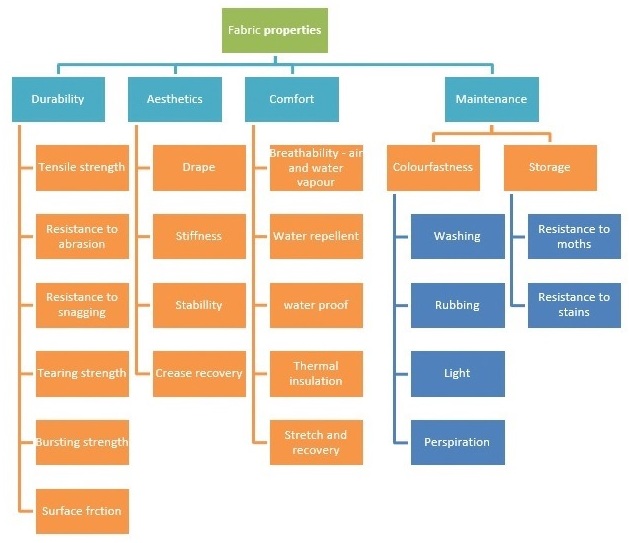Fabric Characteristics:
In garment manufacturing the main raw material used is fabric (textile material) which is either woven or knitted (sometimes nonwoven is also used for some specific products). In addition to textile fabrics, sometimes leather and fur are also used in garment manufacturing. The fabric should have appropriate texture and color according to end use.
Fabric characteristics distinguish one fabric from another. Examining construction, texture, hand, and weight will help you identify the many fabrics available. Fabric characteristics / properties are explain in below image.

Principle characteristics of fabric are discussed below:
1. Construction:
Fibers and yarns become fabric when they are joined by a construction method. The two most common methods are weaving and knitting. Weaving interlaces two sets of yarns that are at right angles to each other. Knitting loops yarns together. Other methods used to make a few fabrics include interlocking, fusing, bonding, twisting, and looping. Construction easily identifies some fabrics. You can recognize terrycloth by its loops. Velvet has a raised surface, while corduroy has rows of cut threads. A special weave produces the shiny look of satin, and felt has interlocked fibers matted together.
2. Texture:
How does the surface of a fabric look and feel to the touch? Smooth, rough, dull, shiny, nubby, fuzzy, and combinations of these all describe a fabric’s texture.
3. Hand:
How does a fabric react as you handle it? Is it soft and pliant, firm, stiff, or crisp? You can learn how a fabric behaves by draping it over your hands.
4. Weight:
The yarns and fabric construction determine the weight of a fabric. Fabrics range in weight from very light to very heavy.
Moreover, from users’ point of view the following fabric characteristics are very much important:
- Drapeability
- Wrinkle resistance
- Dimensional stability
- Durability
- Air permeability
- Soft handle
- Light weight
- Ease of care
Evaluate Fabric Characteristics:
To find out whether a fabric is right for your purposes, try the tests described here:
Drapability:
Does the fabric fall into soft, natural folds, indicating it drapes well? Hold the fabric between your hands. Move your hands together while slowly gathering the fabric. Are the folds sharp and crisp or soft and flowing?
Wrinkle resistance:
Will a garment crease or wrinkle during wear? Grab a fistful of fabric and squeeze for about 20 seconds. Release and check for wrinkles. Shake the fabric several times or smooth it with your hand. Wait about 40 seconds. Are the wrinkles disappearing?
Strength:
Does the fabric resist tearing? High tearing strength is useful in children’s clothes, work clothes, and activewear. Make a scissors cut in the edge of the fabric (not a garment). Then try to tear the fabric by hand. Does the fabric tear easily?
Shape retention:
Will knitted fabric keep its shape after wearing? Stretch a knitted garment with your hands, looking for reasonable resistance. If it stretches too easily, the shape may not come back, as on baggy sweater elbows and knees of pants.
Air permeability:
Will the fabric allow air to pass through? Fabrics that “breathe” have high air permeability for more comfort in hot or humid weather. In cold or windy weather, fabric needs low air permeability. Hold the fabric tightly against your mouth and exhale. Evaluate the amount of pressure needed to blow air through.
Cover:
Does light shine through the fabric? A fabric with low cover is somewhat translucent. A navy shirt shouldn’t show through when tucked into light colored pants. Place a light colored fabric over one with a darker color. If the lighter fabric has adequate cover, the darker fabric won’t be visible.
You may also like: 100 Different Types of Fabric and Their Uses
